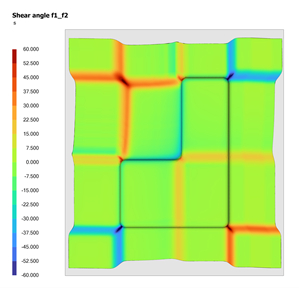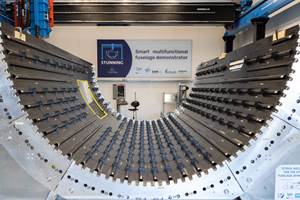AniForm, Moldex3D develop interface tool for more accurate RTM prediction analysis
Interface enables users to consider forming-induced fiber reorientation in the RTM simulation model for a more accurate representation of the flow domain.

All photo credit: AniForm, Moldex3D
AniForm Engineering (Enschede, Netherlands), an advanced simulation tool that predicts the formability of composite laminates, is collaborating with Moldex3D (St. Zhubei City, Taiwan) to enable users to run more accurate resin transfer molding (RTM) analyses. With this new interface, workflow has been improved to smoothly import the fiber reorientation data (recorded as an ASCII file) from AniForm Suite and run the RTM simulation with Moldex3D’s simulation tools. Additionly, input accuracy for the RTM model has been optimized and RTM simulation results made more accurate.
“AniForm strives to deliver a software tool that enables engineers to focus on the analysis of a prediction, rather than spending too much time on modeling and data transfer between various simulation tools,” says Sebastiaan Haanappel, managing director at AniForm. “Moldex3D is a renowned partner in the industry, so we were thrilled to cooperate with them. We were very happy with this collaborative effort, which led to a seamless interface between our tools.”
When coming up with the solution, both AniForm and Moldex3D focused on targeting the following challenges:
- Lack of a seamless workflow between the different simulation tools;
- The fiber orientations in a fabric change significantly during forming;
- Fabric shear and fiber reorientation locally affects the magnitude and orientation of the fabric’s permeability property.

To address these, a case study was performed, with the main objective to compare the different results between two models; one that directly assigned an assumed orthogonal fabric orientation, and one that considered the fabric orientation result from an AniForm forming prediction. The goal was to see how different inputs can have a significant impact on the resin infusion simulation results.
First, AniForm’s team generated a simulation of a woven fabric forming that was then used as an input in Moldex3D software for the fabric orientation. The fabric simulation was exported as an ASCII file from AniForm and imported in Moldex3D to run the RTM simulation.
Then, the part was created. A laminate consisting of five fabric layers with a [(0/90)]5 layup was formed into a mold cavity, which represents the final part shape. Subsequently, the mold itself was heated and injected with resin, with a final part released after curing. This part was referred to as the Formed Woven Fabric (Fig. 2).

Fig. 3. AniForm forming predictions at various instances.
To take into consideration the forming induced fabric distortions in a subsequent infusion simulation in Moldex3D, a composite forming simulation in AniForm was performed. Fig. 3 shows the predicted laminate deformations at various instances during the forming. These deformations led to the resulting in-plane shear distribution and related fiber re-orientation at complete mold closure in the final step as shown in Fig 4.

Fig. 4. Shear angle distribution predicted by AniForm.
Two infusions model configurations were created in Moldex3D (see Fig. 5). The first model assumes the fabric still to be orthogonal, namely 0º and 90º in every part (light blue: 0º, dark blue: 90º). However, Moldex3D and AniForm note that, in reality, an orthogonal fiber orientation will not be present since the forming leads to in-plane fabric deformation, meaning the fabric orientation will no longer be 0º and 90 in every part. Therefore, the second model considers the forming results from AniForm, using the forming induced fiber-reorientation. Because the fiber reorientation affects permeability (indicated in Fig. 6), Moldex3D and AniForm believe the second model to result in a more accurate representation.

Fig. 5. Fabric orientation.

Fig. 6. Flow front.
Thus, the case study concluded that the developed interface, improving the estimation of the flow progression over time, enables engineers to better anticipate changes in the process configuration and production cycle durations, as well as a higher degree of confidence when analyzing and interpreting the results.
“We are delighted to cooperate with AniForm, which is undoubtedly a remarkable player in our industry,” says Dannick Teng, managing director at Moldex3D. “This is the first step of Moldex3D and AniForm’s collaboration, and we are both looking forward to further integration soon.”
For more information, please contact support.eu@moldex3d.com or info@aniform.com
Related Content
3D-printed CFRP tools for serial production of composite landing flaps
GKN Aerospace Munich and CEAD develop printed tooling with short and continuous fiber that reduces cost and increases sustainability for composites production.
Read MoreJeep all-composite roof receivers achieve steel performance at low mass
Ultrashort carbon fiber/PPA replaces steel on rooftop brackets to hold Jeep soft tops, hardtops.
Read MoreMaterials & Processes: Tooling for composites
Composite parts are formed in molds, also known as tools. Tools can be made from virtually any material. The material type, shape and complexity depend upon the part and length of production run. Here's a short summary of the issues involved in electing and making tools.
Read MoreThermoplastic composites welding: Process control, certification, crack arresters and surface prep
More widespread use of welded composite structures within a decade? Yes, but further developments are needed.
Read MoreRead Next
From the CW Archives: The tale of the thermoplastic cryotank
In 2006, guest columnist Bob Hartunian related the story of his efforts two decades prior, while at McDonnell Douglas, to develop a thermoplastic composite crytank for hydrogen storage. He learned a lot of lessons.
Read MoreComposites end markets: Energy (2024)
Composites are used widely in oil/gas, wind and other renewable energy applications. Despite market challenges, growth potential and innovation for composites continue.
Read MoreCW’s 2024 Top Shops survey offers new approach to benchmarking
Respondents that complete the survey by April 30, 2024, have the chance to be recognized as an honoree.
Read More

















.jpg;maxWidth=300;quality=90)








